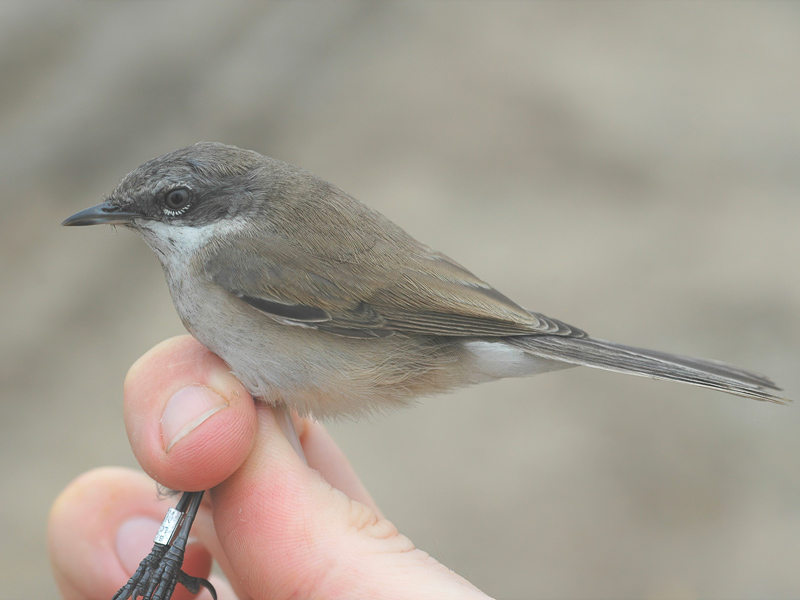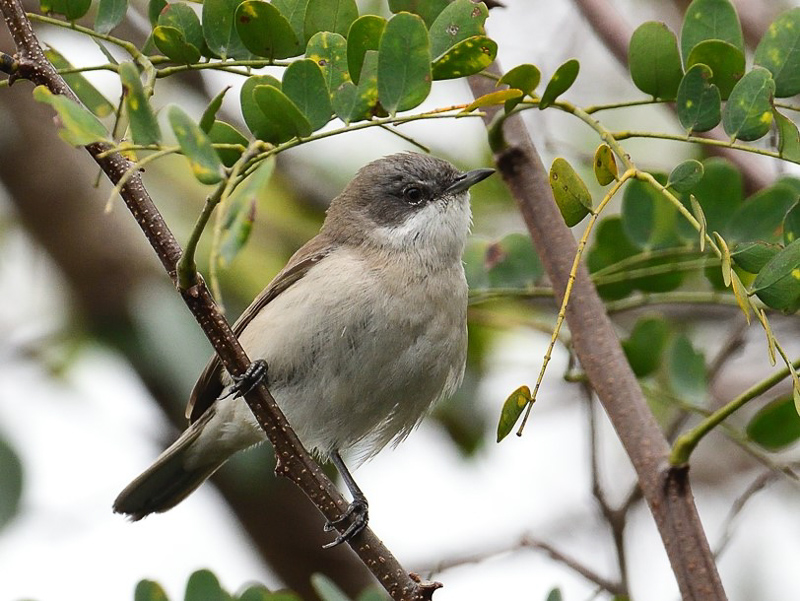Lesser Whitethroat Curruca curruca 白喉林鶯
Category I. Accidental.
IDENTIFICATION

Oct. 2006, Paul Leader. C. c. blythi.
12-13.5 cm. Small, compact warbler that is brown above with a greyer head and whitish below with white throat and buffish flanks; tail has varying amount of white in outer feathers. Bill and legs are dark. Forages unobtrusively in the undergrowth occasionally uttering its call which is similar to that of Dusky Warbler. The darkness of this bird, including the dark and obvious mask, favours Lesser Whitethroat, as was confirmed by its DNA.

Jan. 2017, Kinni Ho. C. curruca or C. minula.
This paler bird with less obvious mask could be either Lesser Whitethroat or Desert Whitethroat.
VOCALISATIONS
The typical contact call of blythi is very similar to Dusky Warbler but slightly softer.
DISTRIBUTION & HABITAT PREFERENCE
The record of blythi involved a bird trapped at Mai Po NR. The remaining records occurred in urban park-like and residential edge habitats or shrub-grass.
OCCURRENCE
2006: one trapped at Mai Po NR on 15 October was identified as C. c. blythi based on DNA analysis of a feather sample.
The remaining records may refer to either C. curruca or Desert Whitethroat C. minula.
2002: one at Yin Kong on 7 October 2002 (Leven and Ying 2007).
2017: one at Lai Chi Kok during 10-11 January.
2017: one at Tsim Bei Tsui from 22 January 2017 to 8 February 2018.
BEHAVIOUR, DIET & FORAGING
Forages in open- and closed-canopy shrubland and in trees.
RANGE & SYSTEMATICS
Widespread species that breeds from the Arctic Circle south as far as 40oN but reaches 30oN in Iran; winters in east Africa, the Middle East and the Indian subcontinent (Aymí and Gargallo 2021). In China breeds in the northwest and north (Liu and Chen 2020).
Three subspecies are recognised. The taxon identified with certainty in HK is C. c. blythi, which breeds in north central Siberia and north Kazakhstan to north Mongolia. In addition, C. c. halimodendri breeds from southeast Russia, Kazakhstan, Uzbekistan and Turkmenistan to north Xinjiang and northwest Mongolia, while the nominate form breeds from Europe to west Siberia and south to Asia Minor and north Iran. In China blythi breeds in the Altai in north Xinjiang while halimodendri breeds in arid lowland areas of eastern Xinjiang and north China (Liu and Chen 2020).
CONSERVATION STATUS
IUCN: Least Concern. Population trend stable.
Aymí, R. and G. Gargallo (2021). Lesser Whitethroat (Curruca curruca), version 1.1. In Birds of the World (J. del Hoyo, A. Elliott, J. Sargatal, D. A. Christie, and E. de Juana, Editors). Cornell Lab of Ornithology, Ithaca, NY, USA. https://doi.org/10.2173/bow.leswhi4.01.1
Leven, M. R. and H. K. Ying (2007). Lesser Whitethroat Sylvia curruca at Yin Kong. The first Hong Kong record. Hong Kong Bird Report 2001-02: 193-195.
Liu, Y. and Y. H. Chen (eds) (2020). The CNG Field Guide to the Birds of China (in Chinese). Hunan Science and Technology Publication House, Changsha.

